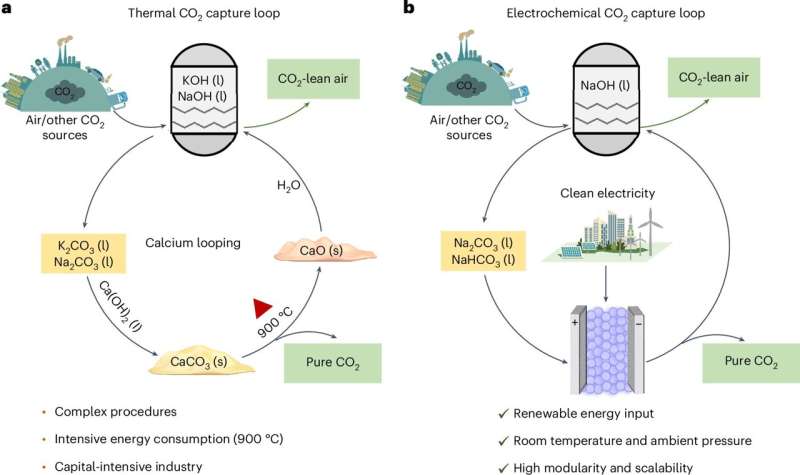
October 29, 2024 by Rice University
Collected at: https://techxplore.com/news/2024-10-electrochemical-reactor-air-capture-energy.html
Rice University researchers have developed an electrochemical reactor that has the potential to drastically reduce energy consumption for direct air capture, the removal of carbon dioxide directly from the atmosphere.
The new reactor design could be a part of the solution to the pressing problem of emission impacts on the climate and biosphere by enabling more agile and scalable carbon dioxide mitigation strategies.
A study in Nature Energy describes the specialized reactor as having a modular, three-chambered structure with a carefully engineered porous solid electrolyte layer at its core. Haotian Wang, a Rice chemical and biomolecular engineer whose lab has been researching industrial decarbonization and energy conversion and storage solutions, said the work “represents a big milestone in carbon capture from the atmosphere.”
“Our research findings present an opportunity to make carbon capture more cost-effective and practically viable across a wide range of industries,” said Wang, the corresponding author on the study and associate professor of chemical and biomolecular engineering.
The device has achieved industrially relevant rates of carbon dioxide regeneration from carbon-containing solutions. Its performance metrics, including its long-term stability and adaptability to different cathode and anode reactions, showcase its potential for wide-scale industrial use.
“One of the major draws of this technology is its flexibility,” said Wang, explaining that it works with different chemistries and can be used to cogenerate hydrogen. “Hydrogen coproduction during direct air capture could translate into dramatically lower capital and operation costs for downstream manufacturing of net-zero fuels or chemicals.”
The new technology offers an alternative to the use of high temperatures in direct air capture processes, which often involve running a mixed gas stream through high-pH liquids in order to filter out carbon dioxide, an acidic gas. This first step of the process ties up the carbon and oxygen atoms in the gas molecules to other compounds in the liquid, forming new bonds of varying degrees of strength depending on the type of chemical used to trap the carbon dioxide.
The next major step in the process involves retrieving the carbon dioxide from these solutions, which can be done using either heat, chemical reactions or electrochemical processes.
Zhiwei Fang, a Rice postdoctoral researcher who is a study co-first author, said conventional direct air capture technologies tend to use high-temperature processes to regenerate carbon dioxide from sorbent, or the carbon dioxide-filtering agent.
“Our work focused on using electrical energy instead of thermal energy to regenerate carbon dioxide,” Fang said, adding that the approach has several additional benefits, including it works at room temperature, needs no additional chemicals and generates no unwanted byproducts.
The types of chemicals used to trap the carbon dioxide have different drawbacks and advantages. Amine-based sorbents are the most widely used, in part because they tend to form weaker bonds, which means less energy is required to take the carbon dioxide back out of the solution. However, they are highly toxic and unstable. Even though basic water-based solutions using sorbents like sodium hydroxide and potassium hydroxide are a greener alternative, they require much higher temperatures to release the carbon dioxide back out.
“Our reactor can efficiently split carbonate and bicarbonate solutions, producing alkaline absorbent in one chamber and high-purity carbon dioxide in a separate chamber,” said Wang. “Our innovative approach optimizes electrical inputs to efficiently control ion movement and mass transfer, reducing energy barriers.”
Wang said he hopes the research will motivate more industries to pursue sustainable processes and fuel the momentum toward a net-zero future.
Other authors on the study are former Rice postdoctoral researcher Xiao Zhang and Rice doctoral alumni and former postdoctoral scientists Peng Zhu and Yang Xia.
More information: Xiao Zhang et al, Electrochemical regeneration of high-purity CO2 from (bi)carbonates in a porous solid electrolyte reactor for efficient carbon capture, Nature Energy (2024). DOI: 10.1038/s41560-024-01654-z
Journal information: Nature Energy

Leave a Reply